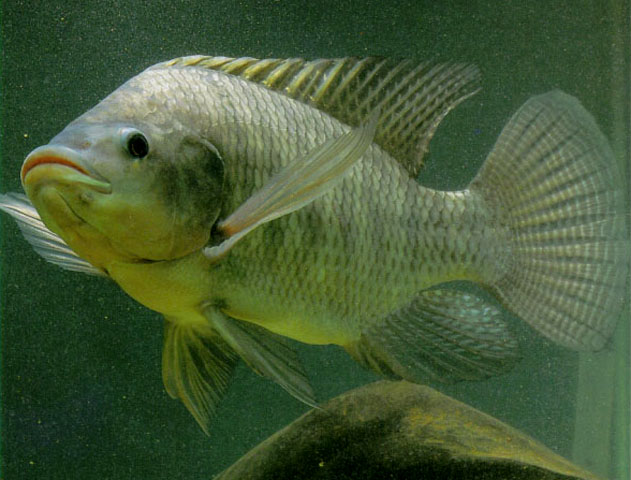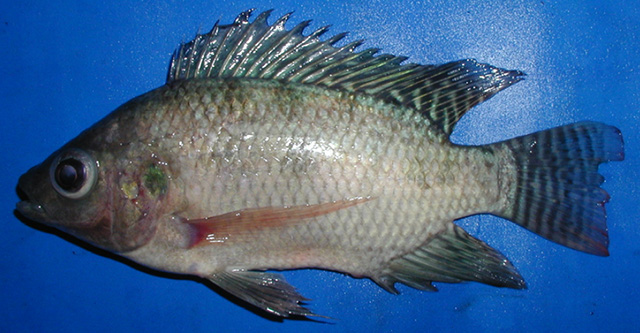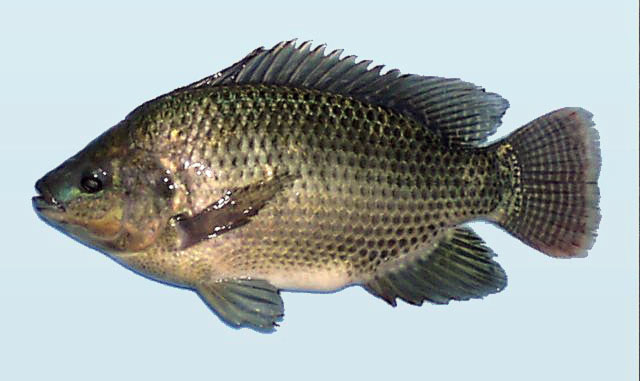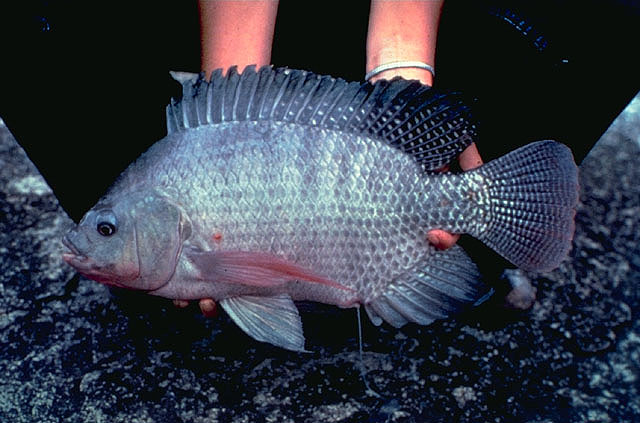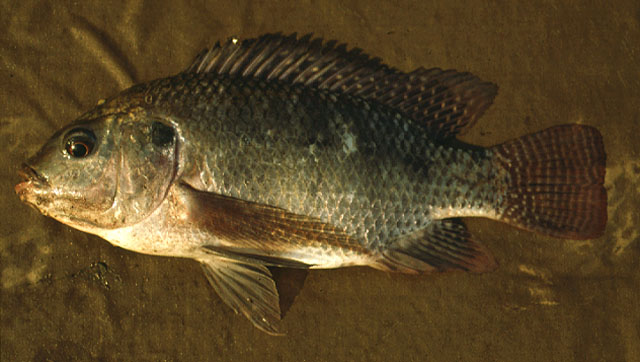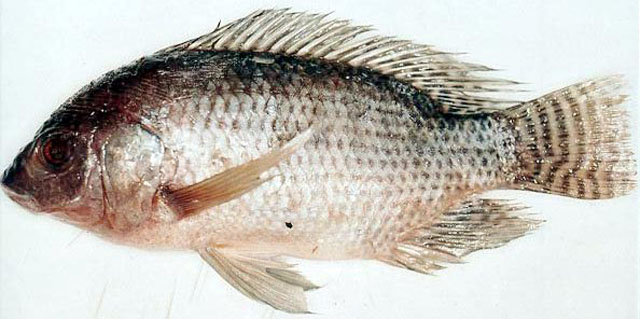Oreochromis
niloticus
(Linnaeus,
1758)
Nile tilapia
View all media / Upload your photos and videos
Expand all
Classification / Names
Teleostei (teleosts) > Cichliformes (Cichlids, convict blennies) >
Cichlidae (Cichlids)
> Pseudocrenilabrinae
Etymology: Oreochromis: Latin, aurum = gold + Greek, chromis = a fish, perhaps a perch (Ref. 45335).
More on author:
Linnaeus.
Environment / milieu / depth range / climate zone / distribution range
Distribution
Africa: naturally occurring in coastal rivers of Israel (Ref. 5166), Nile basin (including lake Albert, Edward and Tana), Jebel Marra, Lake Kivu, Lake Tanganyika, Awash River, various Ethiopian lakes, Omo River system, Lake Turkana, Suguta River and Lake Baringo (Ref. 2). In West Africa natural distribution covers the basins of the Senegal, Gambia, Volta, Niger, Benue and Chad, with introduced specimens reported from various coastal basins (Ref. 53405). Widely introduced for aquaculture, with many existing strains. Several countries report adverse ecological impact after introduction. The following subspecies were previously recognized: Oreochromis niloticus baringoensis, Oreochromis niloticus cancellatus, Oreochromis niloticus eduardianus, Oreochromis niloticus filoa, Oreochromis niloticus niloticus, Oreochromis niloticus sugutae, Oreochromis niloticus tana and Oreochromis niloticus vulcani.
Length at first maturity / Size / Weight / Age
Short description
Dorsal spines (total): 15 - 18; Dorsal soft rays (total): 11 - 13; Anal spines: 3; Anal soft rays: 9 - 11; Vertebrae: 30 - 32. Diagnosis: A large deep-bodied tilapia, with a relatively small head (Ref. 118638). Jaws of mature male not greatly enlarged, length of lower jaw 29-37% of head length; genital papilla of breeding male not tassellated (Ref. 2). Body depth 36-50% of SL (Ref. 28714). Most distinguishing characteristic is the presence, at all life stages, of regular vertical stripes throughout depth of caudal fin (Ref. 4967, 53405, 118638). In smaller fishes, these are relatively wide and form an arc, and start at the base of the caudal fin (Ref. 118638). Males are bluish pink, sometimes with a dark throat, belly, anal and pelvic fins; females are usually brownish, silvery/white beneath with around 10 thin vertical bars (Ref. 118638). Description: Lower pharyngeal bone longer than broad, its anterior part longer than toothed part; outer jaw teeth bicuspid, inner jaw teeth tricuspid, posterior pharyngeal teeth bicuspid and stout; 3-4 rows of teeth in jaws (3-5, rarely 6, in specimens over 200 mm SL); micro-gillrakers present; scales cycloid (Ref. 53405). Coloration: margin of dorsal fin grey or black; vertical bars in caudal fin 7-12 (Ref. 2). Regular black cross bars on caudal fin; ground colour greyish, relatively dark in adults; back olivaceous-green, sides paler, with 6-9 rather indistinct cross bars; belly whitish; upper lip pale green or white, lower lip white; dorsal and anal fins greyish, sometimes with very narrow red margin, soft part of fin with vertical lines (or with aligned light spots resembling striped pattern); pelvic fins grey, pectorals transparent; "tilapian" spot lacking in adults but very distinct in fingerlings which also have more distinct cross bars and very prominent black spot on upper part of caudal peduncle; throat, belly and unpaired fins black in mature males (Ref. 53405). Head and trunk in breeding male suffused with red (Ref. 28714).
Biology
Occurs in a wide variety of freshwater habitats like rivers, lakes, sewage canals and irrigation channels (Ref. 28714). Does not do well in pure salt water, but is able to survive in brackish water (Ref. 52307). Mainly diurnal. Feeds mainly on phytoplankton or benthic algae. Additionally, insect larvae are of some importance, as are aufwuchs and detritus; juveniles tend to be more omnivorous than adults (Ref. 52307). Oviparous (Ref. 205), ovophilic (Ref. 52307). A maternal mouthbrooder (Ref. 2, 28714, 52307, 118638), males dig simple pits in shallow water (Ref. 118638). May mature early (about 11 cm TL females, 14 cm TL males) (Ref. 28714). Globally, the most important tilapia species in fish farming and supports major capture fisheries where established; generally highly invasive and known to hybridise with many other Oreochromis species and for this reason further stocking has been banned in a number of countries, e.g. South Africa, Malawi and Zambia (Ref. 118638). Extended temperature range 8-42 °C, natural temperature range 13.5 - 33 °C (Ref. 3). Maximum depth from Ref. 34290Marketed fresh and frozen (Ref. 9987).
Life cycle and mating behavior
Sexual maturity is reached at 3-6 months depending on temperature, reaching about 30 g. Reproduction occurs only when temperatures are over 20°C. Several yearly spawnings every 30 days. Females incubate eggs inside their mouths (approximately for a week) where larvae hatch and remain until the vitellus is reabsorved. Egg size 1.5 mm, larval length at hatching 4 mm. Spawns in firm sand in water from 0.6 to 2 m deep of lakes (Ref. 2) and inshore waters (Ref. 55624). Males set up and defend territory which are visited by the females. Courtship lasts several hours. A single male probably fertilises the eggs of more than one female (Ref. 55624). Eggs are shed in batches in shallow nest and fertilized by male. Each batch of eggs is picked up into oral cavity by female. Females solely involved in broodcare. Female carries up to 200 eggs in her mouth where the larvae hatch and remain until after the yolk-sac is absorbed.
Main reference
Trewavas, E. 1983 Tilapiine fishes of the genera Sarotherodon, Oreochromis and Danakilia. British Mus. Nat. Hist., London, UK. 583 p. (Ref. 2)
IUCN Red List Status (Ref. 125652)
Least Concern (LC); date assessed: April 06 2020
CITES (Ref. 131153)
Not Evaluated
CMS (Ref. 116361)
Not Evaluated
Threat to humans
Potential pest
More information
- Countries
- FAO areas
- Ecosystems
- Occurrences
- Introductions
- Stocks
- Ecology
- Diet
- Food items
- Food consumption
- Ration
- Common names
- Synonyms
- Metabolism
- Predators
- Ecotoxicology
- Reproduction
- Maturity
- Spawning
- Spawning aggregation
- Fecundity
- Eggs
- Egg development
- Age/Size
- Growth
- Length-weight
- Length-length
- Length-frequencies
- Morphometrics
- Morphology
- Larvae
- Larval dynamics
- Recruitment
- Abundance
- References
- Aquaculture
- Aquaculture profile
- Strains
- Genetics
- Allele frequencies
- Heritability
- Diseases
- Processing
- Mass conversion
- Vision
- Pictures
- Stamps, Coins Misc.
- Sounds
- Ciguatera
- Speed
- Swim. type
- Gill area
- Otoliths
- Brains
Estimates based on models
Phylogenetic diversity index (Ref. 82804): PD50 = 0.5 [Uniqueness, from 0.5 = low to 2.0 = high].
Bayesian length-weight: a=0.01778 (0.01491 - 0.02121), b=2.99 (2.95 - 3.03), in cm total length, based on LWR estimates for this species (Ref. 93245).
Trophic level (Ref. 69278): 2.0 ±0.0 se; Based on diet studies.
Generation time: 2.9 (2.2 - 3.9) years. Estimated as median ln(3)/K based on 26 growth studies.
Resilience (Ref. 120179): Medium, minimum population doubling time 1.4 - 4.4 years (K=0.14-0.41; tm=1-2; tmax=9; Fec < 1,000).
Fishing vulnerability (Ref. 59153): Low to moderate vulnerability (30 of 100).
Price category (Ref. 80766): Unknown.
Nutrients (Ref. 124155): Calcium = 40.6 [5.6, 397.5] mg/100g; Iron = 3.21 [1.27, 7.98] mg/100g; Protein = 17.7 [15.8, 19.6] %; Omega3 = 0.144 [0.021, 1.033] g/100g; Selenium = 279 [33, 2,176] μg/100g; VitaminA = 0.877 [0.050, 12.397] μg/100g; Zinc = 5.76 [1.85, 10.72] mg/100g (wet weight); based on nutrient studies.

